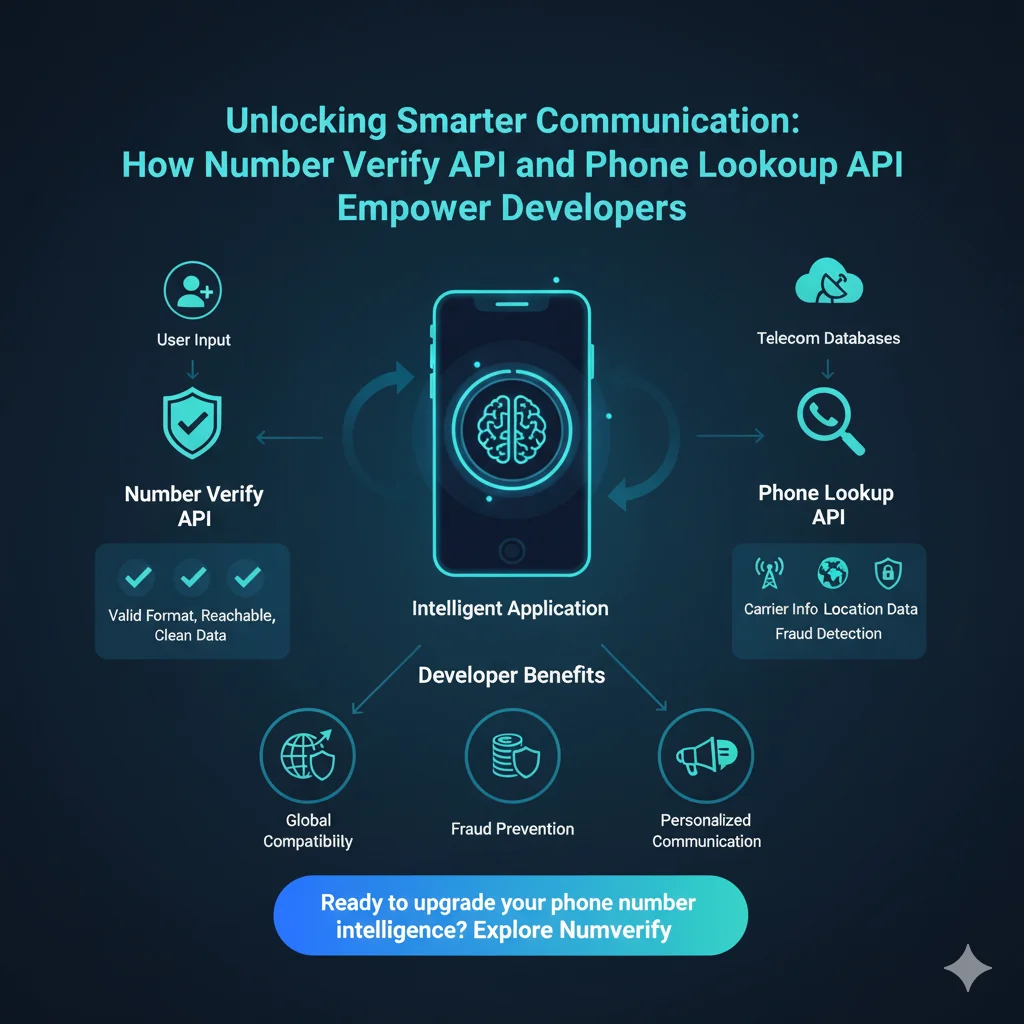Phone numbers are more than just contact details, they’re critical identifiers used for authentication, communication, and personalization. For developers building scalable, secure, and user-friendly applications, integrating a phone validator API and a reverse phone lookup API is a strategic move that enhances data quality, reduces fraud, and improves user experience.
This article explores the functionality, integration strategies, and best practices for using these APIs, offering practical insights for developers across industries.
Why Phone Number Intelligence Matters
Phone number verification is a foundational step in modern application development. Whether you're onboarding users, sending transactional messages, or managing customer records, ensuring that phone numbers are valid and enriched with metadata is essential.
A phone validator API helps confirm that a number is correctly formatted, reachable, and associated with a legitimate line type (mobile, landline, VoIP). Meanwhile, a reverse phone lookup API retrieves additional details such as carrier name, location, and risk indicators, enabling smarter decision-making and personalized communication.
Together, these APIs empower developers to build applications that are secure, efficient, and globally compatible.
API Functionality: What These Tools Do
Phone Validator API
A phone validator API performs real-time checks on phone numbers to ensure they are:
-
Properly formatted (E.164, national, international)
-
Valid and active
-
Associated with a known line type
-
Located in a specific country or region
This API is typically used during user registration, form submissions, and contact management to prevent invalid or fake entries.
Reverse Phone Lookup API
A reverse phone lookup API enriches phone number data by querying telecom databases. It returns:
-
Carrier name (e.g., Vodafone, Verizon)
-
Network type (GSM, CDMA, LTE)
-
Ported status (has the number changed carriers?)
-
Location data (city, region)
-
Risk indicators (spam, fraud potential)
This API is valuable for fraud detection, lead scoring, and routing logic in communication platforms.
Integration: How Developers Can Get Started
Integrating these APIs into your application is straightforward. Most providers offer RESTful endpoints with JSON responses, making them compatible with any modern tech stack.
Step-by-Step Integration
-
Choose a Provider
Services like Numverify offer robust APIs with global coverage and developer-friendly documentation. -
Get Your API Key
Sign up and obtain your authentication token for secure access.
Make a Request
Use HTTP GET or POST to query the API with the phone number.
GET https://api.numverify.com/validate?access_key=YOUR_API_KEY&number=+14158586273
Parse the Response
Extract relevant fields such as valid, carrier, line_type, and location.
{
"valid": true,
"number": "+14158586273",
"local_format": "4158586273",
"international_format": "+14158586273",
"country": "United States",
"location": "San Francisco",
"carrier": "AT&T",
"line_type": "mobile"
}
-
Embed into Workflow
Use the data to validate inputs, enrich user profiles, or trigger conditional logic (e.g., flagging VoIP numbers).
Best Practices for Implementation
To maximize the value of these APIs, developers should follow a few key practices:
-
Validate Early: Integrate phone validation at the point of data entry to catch errors before they propagate.
-
Cache Responses: Reduce API calls by caching validated numbers and carrier data.
-
Handle Errors Gracefully: Implement fallback logic for unreachable or invalid numbers.
-
Monitor Usage: Track API usage to stay within provider quotas and optimize performance.
-
Secure API Keys: Store credentials securely and rotate them periodically.
Use Cases Across Industries
🛍️ E-Commerce
Validate customer numbers during checkout to reduce delivery errors and enable SMS order updates.
💳 Fintech
Prevent fraud by validating phone numbers during account creation, KYC, and transaction verification.
🏥 Healthcare
Ensure accurate patient contact information for appointment reminders and telehealth services.
📞 Call Centers
Use reverse phone lookup API to identify caller details and route calls more efficiently.
📊 Marketing Automation
Segment leads based on carrier, location, or line type to improve targeting and ROI.
Security Considerations
Handling phone number data requires careful attention to privacy and compliance. Here’s how developers can protect user data:
-
Use HTTPS: Encrypt all API requests and responses.
-
Minimize Data Storage: Store only necessary fields and avoid retaining sensitive metadata.
-
Comply with Regulations: Follow GDPR, TCPA, and other relevant data protection laws.
-
Audit Access Logs: Monitor who accesses phone data and when.
-
Obtain Consent: Ensure users agree to phone number usage for verification or communication.
Security isn’t just about protecting data, it’s about building trust with your users.
Comparing Verification Services
When choosing a phone validator API or reverse phone lookup API, consider the following factors:
| Feature | Numverify | Twilio | Nexmo | Telesign |
| Global Coverage | ✅ | ✅ | ✅ | ✅ |
| Carrier Lookup | ✅ | ✅ | ✅ | ✅ |
| Line Type Detection | ✅ | ✅ | ✅ | ✅ |
| Real-Time Validation | ✅ | ✅ | ✅ | ✅ |
| Free Tier Availability | ✅ | Limited | Limited | Limited |
| Developer Documentation | ✅ | ✅ | ✅ | ✅ |
Numverify stands out for its simplicity, affordability, and ease of integration, ideal for small teams and startups.
Future Trends in Phone Number Verification
As communication channels evolve, so do the tools that support them. Here are a few trends shaping the future:
-
AI-Powered Risk Scoring: Predict fraud likelihood based on behavioral patterns.
-
Multimodal Verification: Combine phone, email, and biometric data for stronger authentication.
-
Real-Time Portability Checks: Detect carrier changes instantly to maintain message deliverability.
-
Privacy-First APIs: Offer verification without exposing sensitive metadata.
Developers who stay ahead of these trends will be better equipped to build secure, scalable, and user-friendly applications.
FAQs
Q1: What is phone number verification, and how does it work?
Phone number verification confirms that a number is valid, correctly formatted, and reachable. bates this by checking against telecom databases and formatting standards.
Q2: Why is reverse phone lookup important for developers?
A reverse phone lookup API provides metadata like carrier name, network type, and location. This helps optimize routing, detect fraud, and personalize communication.
Q3: How do I choose the right phone number verification API for my project?
Consider factors like global coverage, response speed, data depth, pricing, and ease of integration. Look for APIs with clear documentation and flexible plans.
Q4: What are the security risks associated with phone number verification, and how can they be mitigated?
Risks include data leaks, unauthorized access, and non-compliance. Mitigate them by using HTTPS, securing API keys, minimizing data storage, and following privacy laws.
Q5: Can these APIs be used in real-time applications?
Yes. Both APIs are designed for real-time use cases like onboarding, verification, and communication workflows.
Smarter Data, Smarter Apps
For developers building modern, data-driven applications, integrating a phone validator API and a reverse phone lookup API is a strategic move. These tools not only improve data quality but also enhance security, personalization, and global scalability.
Whether you're validating user inputs, enriching CRM records, or optimizing communication flows, these APIs offer the flexibility and reliability needed to build smarter systems.







